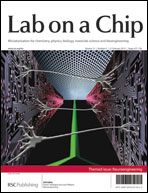Electrokinetic confinement of axonal growth for dynamically configurable neural networks†
Abstract
Axons in the developing nervous system are directed via guidance cues, whose expression varies both spatially and temporally, to create functional neural circuits. Existing methods to create patterns of neural connectivity in vitro use only static geometries, and are unable to dynamically alter the guidance cues imparted on the cells. We introduce the use of AC electrokinetics to dynamically control axonal growth in cultured rat hippocampal neurons. We find that the application of modest voltages at frequencies on the order of 105 Hz can cause developing axons to be stopped adjacent to the electrodes while axons away from the electric fields exhibit uninhibited growth. By switching electrodes on or off, we can reversibly inhibit or permit axon passage across the electrodes. Our models suggest that


 Please wait while we load your content...
Please wait while we load your content...